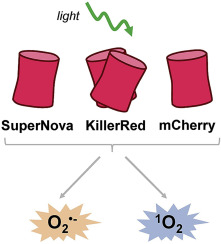当前位置:
X-MOL 学术
›
Free Radical Bio. Med.
›
论文详情
Our official English website, www.x-mol.net, welcomes your feedback! (Note: you will need to create a separate account there.)
Quantification of reactive oxygen species production by the red fluorescent proteins KillerRed, SuperNova and mCherry.
Free Radical Biology and Medicine ( IF 7.4 ) Pub Date : 2019-12-10 , DOI: 10.1016/j.freeradbiomed.2019.12.008 John O Onukwufor 1 , Adam J Trewin 1 , Timothy M Baran 2 , Anmol Almast 1 , Thomas H Foster 2 , Andrew P Wojtovich 1
Free Radical Biology and Medicine ( IF 7.4 ) Pub Date : 2019-12-10 , DOI: 10.1016/j.freeradbiomed.2019.12.008 John O Onukwufor 1 , Adam J Trewin 1 , Timothy M Baran 2 , Anmol Almast 1 , Thomas H Foster 2 , Andrew P Wojtovich 1
Affiliation

|
Fluorescent proteins can generate reactive oxygen species (ROS) upon absorption of photons via type I and II photosensitization mechanisms. The red fluorescent proteins KillerRed and SuperNova are phototoxic proteins engineered to generate ROS and are used in a variety of biological applications. However, their relative quantum yields and rates of ROS production are unclear, which has limited the interpretation of their effects when used in biological systems. We cloned and purified KillerRed, SuperNova, and mCherry - a related red fluorescent protein not typically considered a photosensitizer - and measured the superoxide (O2•-) and singlet oxygen (1O2) quantum yields with irradiation at 561 nm. The formation of the O2•--specific product 2-hydroxyethidium (2-OHE+) was quantified via HPLC separation with fluorescence detection. Relative to a reference photosensitizer, Rose Bengal, the O2•- quantum yield (ΦO2•-) of SuperNova was determined to be 1.5 × 10-3, KillerRed was 0.97 × 10-3, and mCherry 1.2 × 10-3. At an excitation fluence of 916.5 J/cm2 and matched absorption at 561 nm, SuperNova, KillerRed and mCherry made 3.81, 2.38 and 1.65 μM O2•-/min, respectively. Using the probe Singlet Oxygen Sensor Green (SOSG), we ascertained the 1O2 quantum yield (Φ1O2) for SuperNova to be 22.0 × 10-3, KillerRed 7.6 × 10-3, and mCherry 5.7 × 10-3. These photosensitization characteristics of SuperNova, KillerRed and mCherry improve our understanding of fluorescent proteins and are pertinent for refining their use as tools to advance our knowledge of redox biology.
中文翻译:

红色荧光蛋白 KillerRed、SuperNova 和 mCherry 产生的活性氧的定量。
荧光蛋白可通过 I 型和 II 型光敏机制吸收光子后产生活性氧 (ROS)。红色荧光蛋白 KillerRed 和 SuperNova 是经过工程改造的光毒性蛋白,可产生 ROS,可用于各种生物应用。然而,它们的相对量子产率和 ROS 产生率尚不清楚,这限制了对它们在生物系统中使用时的影响的解释。我们克隆并纯化了 KillerRed、SuperNova 和 mCherry(一种通常不被视为光敏剂的相关红色荧光蛋白),并在 561 nm 的照射下测量了超氧化物 (O2•-) 和单线态氧 (1O2) 的量子产率。O2•--特异性产物2-羟基乙锭(2-OHE+)的形成通过HPLC分离和荧光检测进行量化。相对于参考光敏剂 Rose Bengal,SuperNova 的 O2•- 量子产率 (ΦO2•-) 确定为 1.5 × 10-3,KillerRed 为 0.97 × 10-3,mCherry 为 1.2 × 10-3。在 916.5 J/cm2 的激发能量和 561 nm 的匹配吸收下,SuperNova、KillerRed 和 mCherry 分别产生 3.81、2.38 和 1.65 μM O2•-/min。使用探针 Singlet Oxygen Sensor Green (SOSG),我们确定 SuperNova 的 1O2 量子产率 (Φ1O2) 为 22.0 × 10-3、KillerRed 7.6 × 10-3 和 mCherry 5.7 × 10-3。SuperNova、KillerRed 和 mCherry 的这些光敏特性提高了我们对荧光蛋白的理解,并有助于改进它们作为工具的使用,以促进我们对氧化还原生物学的了解。KillerRed 为 0.97 × 10-3,mCherry 为 1.2 × 10-3。在 916.5 J/cm2 的激发能量和 561 nm 的匹配吸收下,SuperNova、KillerRed 和 mCherry 分别产生 3.81、2.38 和 1.65 μM O2•-/min。使用探针 Singlet Oxygen Sensor Green (SOSG),我们确定 SuperNova 的 1O2 量子产率 (Φ1O2) 为 22.0 × 10-3、KillerRed 7.6 × 10-3 和 mCherry 5.7 × 10-3。SuperNova、KillerRed 和 mCherry 的这些光敏特性提高了我们对荧光蛋白的理解,并有助于改进它们作为工具的使用,以促进我们对氧化还原生物学的了解。KillerRed 为 0.97 × 10-3,mCherry 为 1.2 × 10-3。在 916.5 J/cm2 的激发能量和 561 nm 的匹配吸收下,SuperNova、KillerRed 和 mCherry 分别产生 3.81、2.38 和 1.65 μM O2•-/min。使用探针 Singlet Oxygen Sensor Green (SOSG),我们确定 SuperNova 的 1O2 量子产率 (Φ1O2) 为 22.0 × 10-3、KillerRed 7.6 × 10-3 和 mCherry 5.7 × 10-3。SuperNova、KillerRed 和 mCherry 的这些光敏特性提高了我们对荧光蛋白的理解,并有助于改进它们作为工具的使用,以促进我们对氧化还原生物学的了解。我们确定 SuperNova 的 1O2 量子产率 (Φ1O2) 为 22.0 × 10-3、KillerRed 7.6 × 10-3 和 mCherry 5.7 × 10-3。SuperNova、KillerRed 和 mCherry 的这些光敏特性提高了我们对荧光蛋白的理解,并有助于改进它们作为工具的使用,以促进我们对氧化还原生物学的了解。我们确定 SuperNova 的 1O2 量子产率 (Φ1O2) 为 22.0 × 10-3、KillerRed 7.6 × 10-3 和 mCherry 5.7 × 10-3。SuperNova、KillerRed 和 mCherry 的这些光敏特性提高了我们对荧光蛋白的理解,并有助于改进它们作为工具的使用,以促进我们对氧化还原生物学的了解。
更新日期:2019-12-11
中文翻译:

红色荧光蛋白 KillerRed、SuperNova 和 mCherry 产生的活性氧的定量。
荧光蛋白可通过 I 型和 II 型光敏机制吸收光子后产生活性氧 (ROS)。红色荧光蛋白 KillerRed 和 SuperNova 是经过工程改造的光毒性蛋白,可产生 ROS,可用于各种生物应用。然而,它们的相对量子产率和 ROS 产生率尚不清楚,这限制了对它们在生物系统中使用时的影响的解释。我们克隆并纯化了 KillerRed、SuperNova 和 mCherry(一种通常不被视为光敏剂的相关红色荧光蛋白),并在 561 nm 的照射下测量了超氧化物 (O2•-) 和单线态氧 (1O2) 的量子产率。O2•--特异性产物2-羟基乙锭(2-OHE+)的形成通过HPLC分离和荧光检测进行量化。相对于参考光敏剂 Rose Bengal,SuperNova 的 O2•- 量子产率 (ΦO2•-) 确定为 1.5 × 10-3,KillerRed 为 0.97 × 10-3,mCherry 为 1.2 × 10-3。在 916.5 J/cm2 的激发能量和 561 nm 的匹配吸收下,SuperNova、KillerRed 和 mCherry 分别产生 3.81、2.38 和 1.65 μM O2•-/min。使用探针 Singlet Oxygen Sensor Green (SOSG),我们确定 SuperNova 的 1O2 量子产率 (Φ1O2) 为 22.0 × 10-3、KillerRed 7.6 × 10-3 和 mCherry 5.7 × 10-3。SuperNova、KillerRed 和 mCherry 的这些光敏特性提高了我们对荧光蛋白的理解,并有助于改进它们作为工具的使用,以促进我们对氧化还原生物学的了解。KillerRed 为 0.97 × 10-3,mCherry 为 1.2 × 10-3。在 916.5 J/cm2 的激发能量和 561 nm 的匹配吸收下,SuperNova、KillerRed 和 mCherry 分别产生 3.81、2.38 和 1.65 μM O2•-/min。使用探针 Singlet Oxygen Sensor Green (SOSG),我们确定 SuperNova 的 1O2 量子产率 (Φ1O2) 为 22.0 × 10-3、KillerRed 7.6 × 10-3 和 mCherry 5.7 × 10-3。SuperNova、KillerRed 和 mCherry 的这些光敏特性提高了我们对荧光蛋白的理解,并有助于改进它们作为工具的使用,以促进我们对氧化还原生物学的了解。KillerRed 为 0.97 × 10-3,mCherry 为 1.2 × 10-3。在 916.5 J/cm2 的激发能量和 561 nm 的匹配吸收下,SuperNova、KillerRed 和 mCherry 分别产生 3.81、2.38 和 1.65 μM O2•-/min。使用探针 Singlet Oxygen Sensor Green (SOSG),我们确定 SuperNova 的 1O2 量子产率 (Φ1O2) 为 22.0 × 10-3、KillerRed 7.6 × 10-3 和 mCherry 5.7 × 10-3。SuperNova、KillerRed 和 mCherry 的这些光敏特性提高了我们对荧光蛋白的理解,并有助于改进它们作为工具的使用,以促进我们对氧化还原生物学的了解。我们确定 SuperNova 的 1O2 量子产率 (Φ1O2) 为 22.0 × 10-3、KillerRed 7.6 × 10-3 和 mCherry 5.7 × 10-3。SuperNova、KillerRed 和 mCherry 的这些光敏特性提高了我们对荧光蛋白的理解,并有助于改进它们作为工具的使用,以促进我们对氧化还原生物学的了解。我们确定 SuperNova 的 1O2 量子产率 (Φ1O2) 为 22.0 × 10-3、KillerRed 7.6 × 10-3 和 mCherry 5.7 × 10-3。SuperNova、KillerRed 和 mCherry 的这些光敏特性提高了我们对荧光蛋白的理解,并有助于改进它们作为工具的使用,以促进我们对氧化还原生物学的了解。



























 京公网安备 11010802027423号
京公网安备 11010802027423号